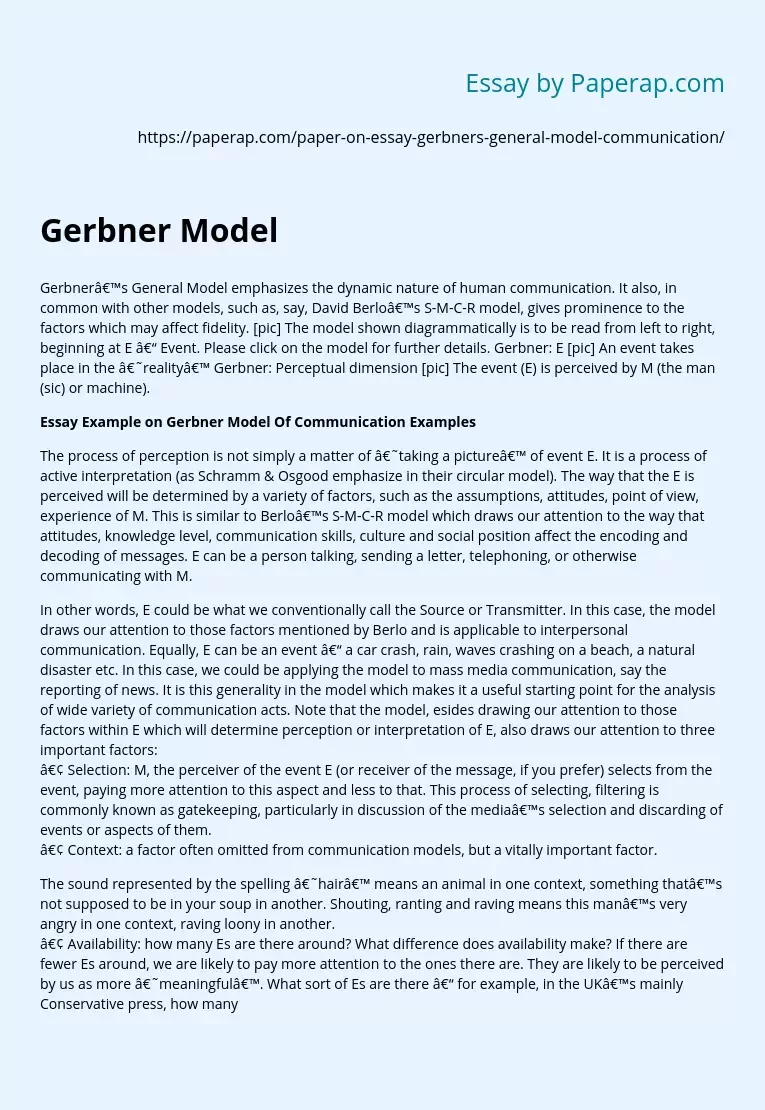Gerbner General Model of Communication Examples
Gerbner’s General Model emphasizes the dynamic nature of human communication. It also, in common with other models, such as, say, David Berlo’s S-M-C-R model, gives prominence to the factors which may affect fidelity. [pic] The model shown diagrammatically is to be read from left to right, beginning at E – Event. Please click on the model for further details. Gerbner: E [pic] An event takes place in the ‘reality’ Gerbner: Perceptual dimension [pic] The event (E) is perceived by M (the man (sic) or machine).
Essay Example on Gerbner Model Of Communication Examples
The process of perception is not simply a matter of ‘taking a picture’ of event E. It is a process of active interpretation (as Schramm & Osgood emphasize in their circular model). The way that the E is perceived will be determined by a variety of factors, such as the assumptions, attitudes, point of view, experience of M. This is similar to Berlo’s S-M-C-R model which draws our attention to the way that attitudes, knowledge level, communication skills, culture and social position affect the encoding and decoding of messages.
E can be a person talking, sending a letter, telephoning, or otherwise communicating with M.
In other words, E could be what we conventionally call the Source or Transmitter. In this case, the model draws our attention to those factors mentioned by Berlo and is applicable to interpersonal communication. Equally, E can be an event – a car crash, rain, waves crashing on a beach, a natural disaster etc.
In this case, we could be applying the model to mass media communication, say the reporting of news. It is this generality in the model which makes it a useful starting point for the analysis of wide variety of communication acts. Note that the model, esides drawing our attention to those factors within E which will determine perception or interpretation of E, also draws our attention to three important factors:
• Selection: M, the perceiver of the event E (or receiver of the message, if you prefer) selects from the event, paying more attention to this aspect and less to that. This process of selecting, filtering is commonly known as gatekeeping, particularly in discussion of the media’s selection and discarding of events or aspects of them.
• Context: a factor often omitted from communication models, but a vitally important factor.
The sound represented by the spelling ‘hair’ means an animal in one context, something that’s not supposed to be in your soup in another. Shouting, ranting and raving means this man’s very angry in one context, raving loony in another.
• Availability: how many Es are there around? What difference does availability make? If there are fewer Es around, we are likely to pay more attention to the ones there are. They are likely to be perceived by us as more ‘meaningful’. What sort of Es are there – for example, in the UK’s mainly Conservative press, how many non-Conservative messages are available to us?
Gerbner General Model of Communication Examples. (2019, Nov 27). Retrieved from https://paperap.com/paper-on-essay-gerbners-general-model-communication/

